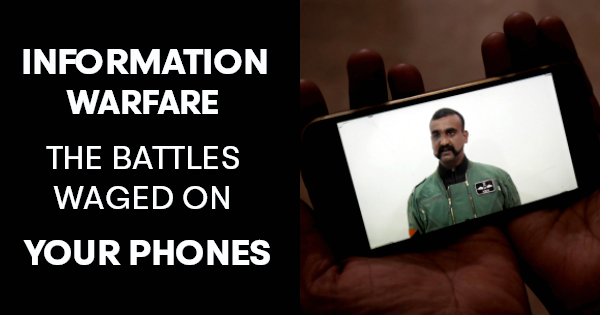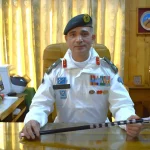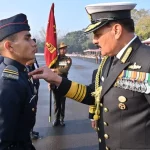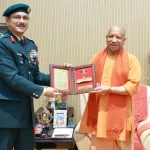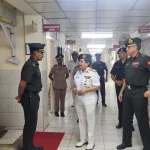War As We Knew It…
Today’s wars are not fought by tanks, aerial bombers or daring infantry charges. Battles in the 21st century are fought in the cities, college campuses, internet forums, and social media newsfeeds. A well-timed Tweet, an errant Facebook group or a seemingly harmless WhatsApp forward holds the potency to be even more dangerous than artillery fire and airstrikes. While the above may be considered a stretch or a radical statement, it does hold water. In today’s information dominated security landscape, a man with a smartphone has the capability to organise widespread hate, radicalise youth, manipulate public opinion against a country’s own military action, crippling a nations ability to fight a conventional conflict.
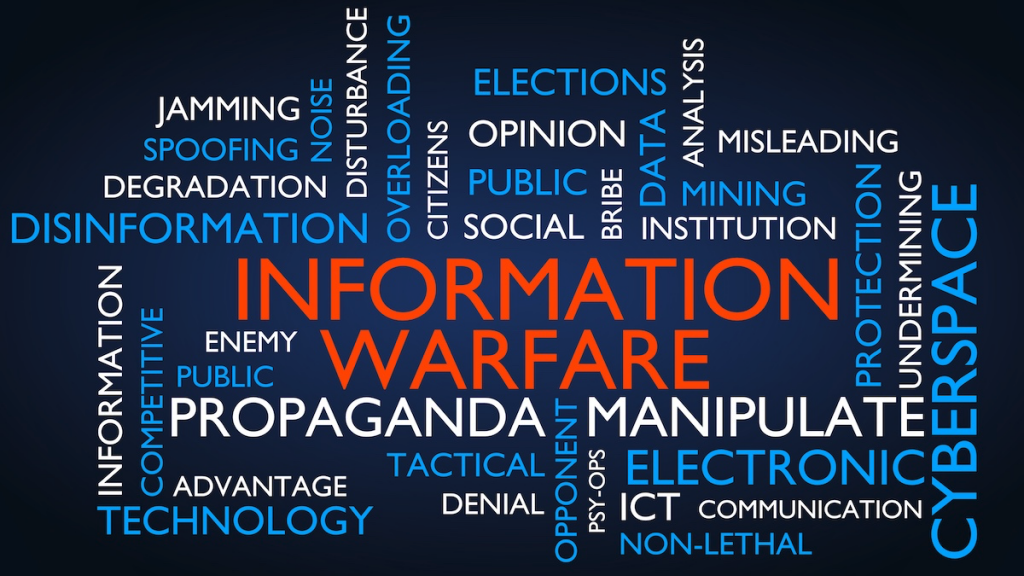
The Art Of Fighting Without Fighting

“The supreme art of war is to subdue the enemy without fighting”
This quote from the 6th century Chinese General, Sun Tzu has never been more relevant than in the 21st century. Military operations today are being undertaken via smartphones as much as it is using conventional forces.
An unverified picture of a child injured in Syria tweeted by a seemingly legitimate twitter handle may be passed off as state-sponsored terrorism by government forces in Kashmir. Similarly, a tweet from a hacked Twitter account of an Indian Army Colonel claiming dissatisfaction towards serving in the military, after Pakistan slaughtered his men, has the potency to alter public opinion against legitimate military action.
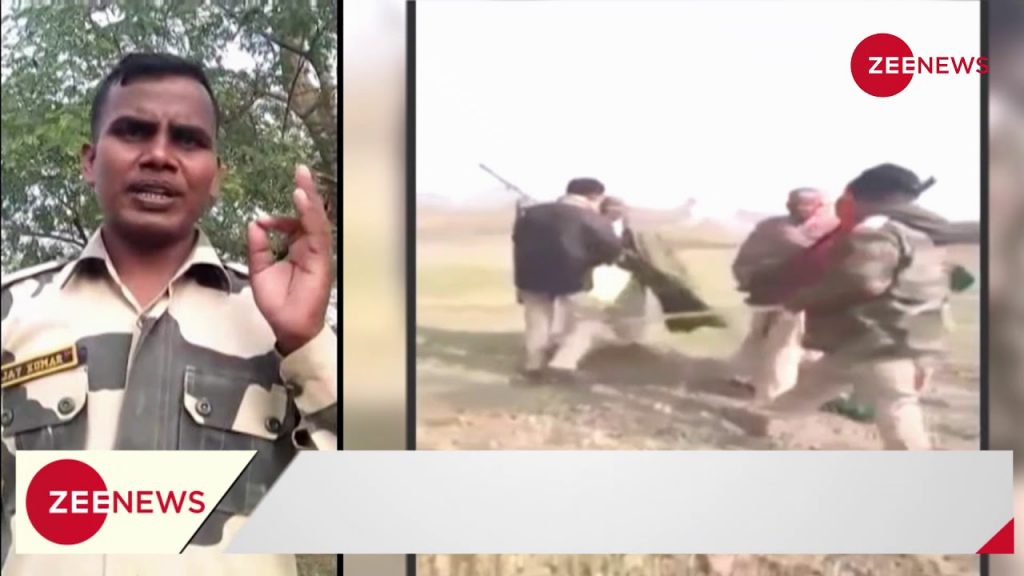
A viral video of a disgruntled BSF jawan complaining about the quality of food while deployed has the potential to cripple the morale of an entire border guarding force. These are present-day military realities
Some Famous Examples Of Media Imagery Changing Public Opinion
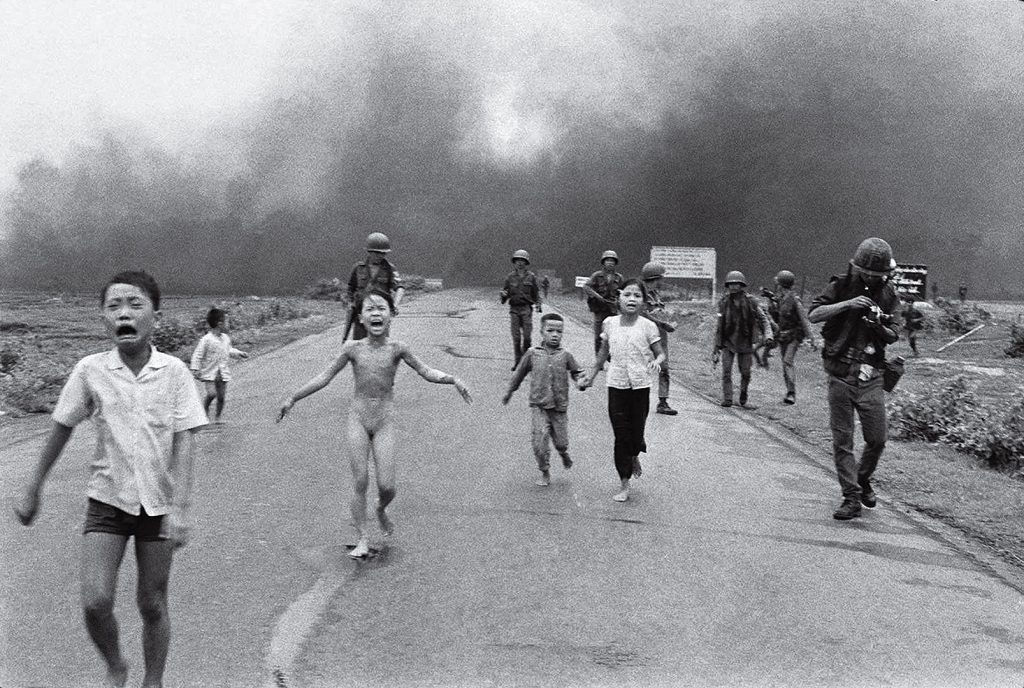
Videos of dead American soldiers being dragged by rebels in Somalia had influenced public sentiments forcing the government to withdraw its soldiers from the country within six months. On the opposite end of the spectrum, a staged US government-sponsored video of a Kuwaiti girl crying in horror about the atrocities of Saddam Hussain’s forces against infants at the children’s hospital, justified public option towards the United States Invasion of Iraq during the First Gulf War in (1991). The girl was later revealed to be the Kuwaiti Ambassadors daughter, with the video being filmed by a prominent Public Relations agency in Washington DC
Public Perception Is Key In Information Warfare
Public perception has indeed proven to be a force multiplier, regularly leveraged by adversaries, in what generals are calling ‘hybrid or designer warfare.’ A significant facet of this new phase of the war is Information Warfare (IW)
What Is Information Warfare?

Information warfare is the tactical/strategic use of information against an enemy. IW is a broad subject with Cyber and electronic warfare playing critical dynamics. However, for this article, the focus will be on social media weaponisation, propaganda and planted/fake news. The implications of these modern-day warfare tools change the battlespace long before the first shot is fired.
What Are PsyOps?

According to Stephanie Hatcher and Military Journalist for the United States Army, “PSYOPs, or “psychological operations,” are overt and covert operations, both tactical and strategic, intended to make a target audience have a planned psychological response.”These are used both as part of Information and Psychological warfare to influence public behaviour, by playing on common emotions, fears and insecurities. PsyOps are now an integral part of modern warfare strategies.
Pakistan’s Black Propaganda Machinery
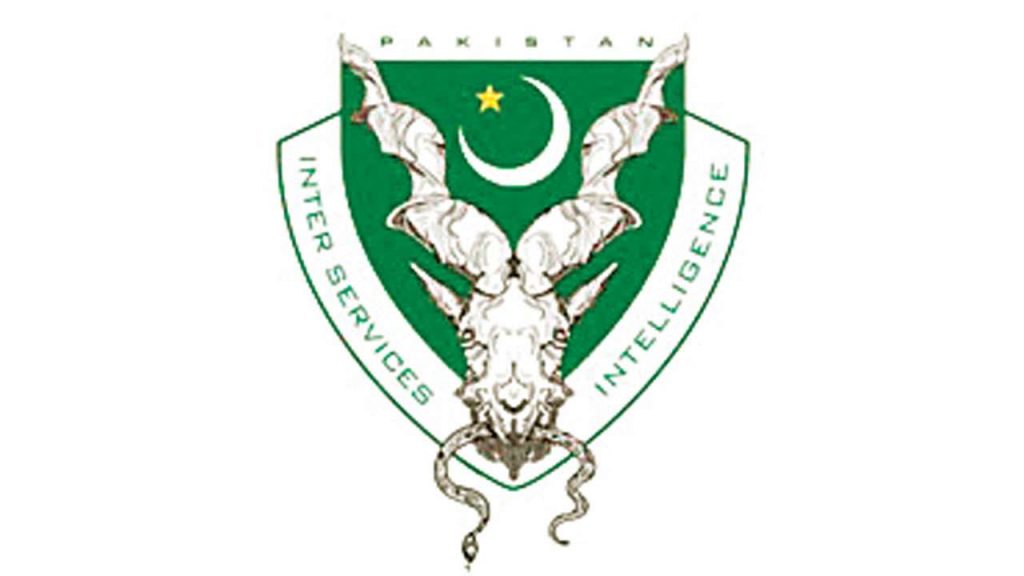
Unable to win in a conventional conflict, India’s western neighbour learnt from their military failure and went on developing one of the most sophisticated PsyOps campaigns in recent history. Islamabad’s unparalleled propaganda machinery has millions of bots, motivated youth, hackers, social media influencers, strategic think tanks and renowned journalists amidst their ranks. The Indian government in its admission (MoD report) has claimed to have mostly been unable to counter the countries well-trenched disinformation campaign.
Islamabad’s PsyOps Units

As aforementioned, Pakistan was a well-organised Information warfare operation with the deployment of both state and non-state actors; it is crucial to critically analyse the two of the most well-known combatants in Islamabad’s PsyOps game.
Inter-Service Public Relations
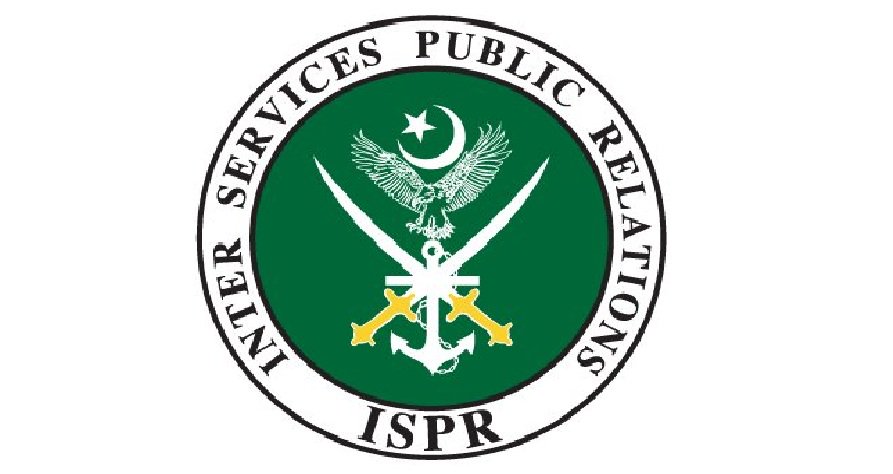
The Pakistani inter-service public relations (ISPR) currently headed by Major General Asif Ghafoor, has been notorious for its organised smear campaigns and planted news stories against the Indian forces.
ISPR’s Recent Operations
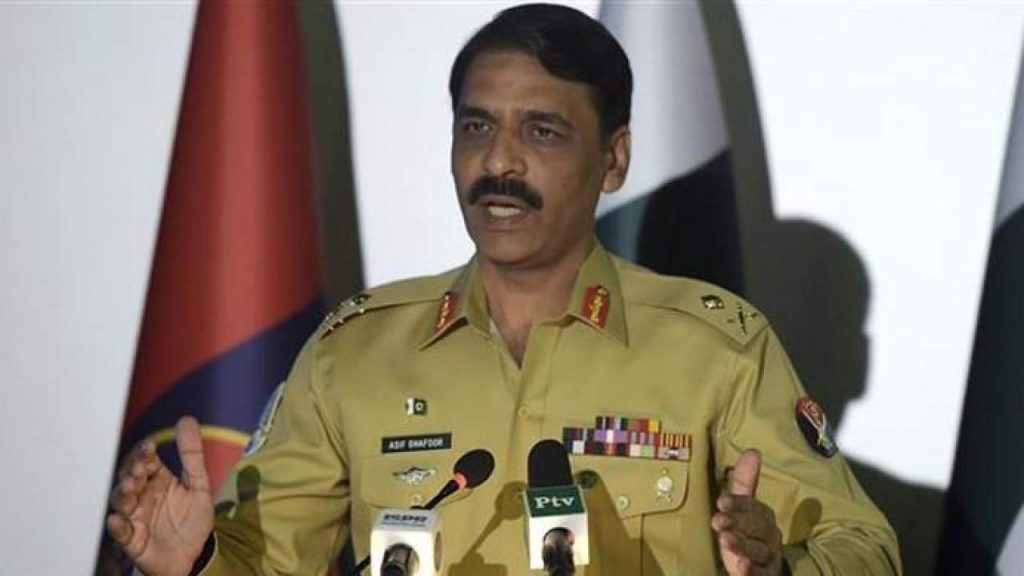
Following the repeal of article 370 which granted the erstwhile state of Jammu and Kashmir, the ISPR upped its operational tempo. Hacking an Indian Army Colonels Twitter account and posting disgruntled posts amidst the communication blockade in the valley. A tweet allegedly from a Colonel Vijay Acharya read
“It’s me Col Acharya from the Indian Army, and I have decided to resign and leave for Delhi. The reason for my resignation is Kashmir; I mean, how can we kills our people. Last night 25 of my unit jawans were killed but no media coverage why? No more tolerance. Bye Indian army!”
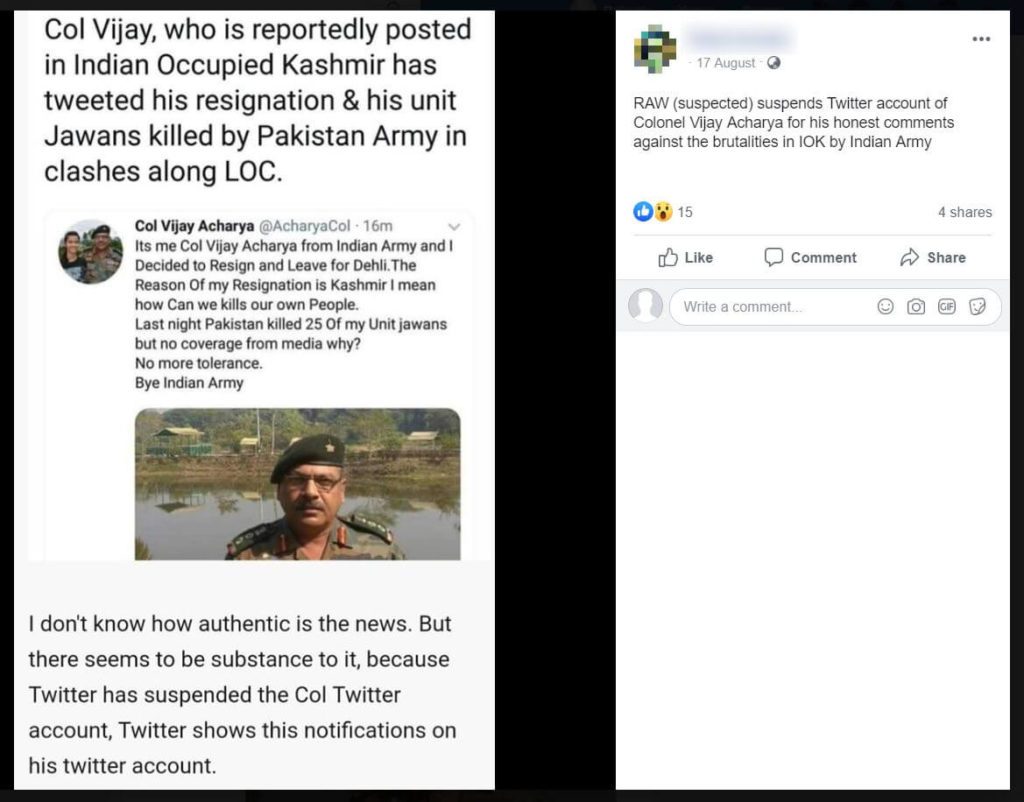

The tweet was proven to be made from a cloned account, with the concerned having already been retired from the service. Moreover, the language used in the tweet was grammatically incorrect, making it unlikely to have been used by an officer of his rank. India allegedly responded immediately to Pakistan’s mischief with a tweet of their own saying
“I am Pakistan Army Colonel Shahid. I have decided to retire early as the Indian Army is killing us on LOC. In last 2 days about 50 Pakistan army has been killed. I request Indian Army not to kill us, I beg them. I have 5000 troops with me who will also retire and leave Pak army.”
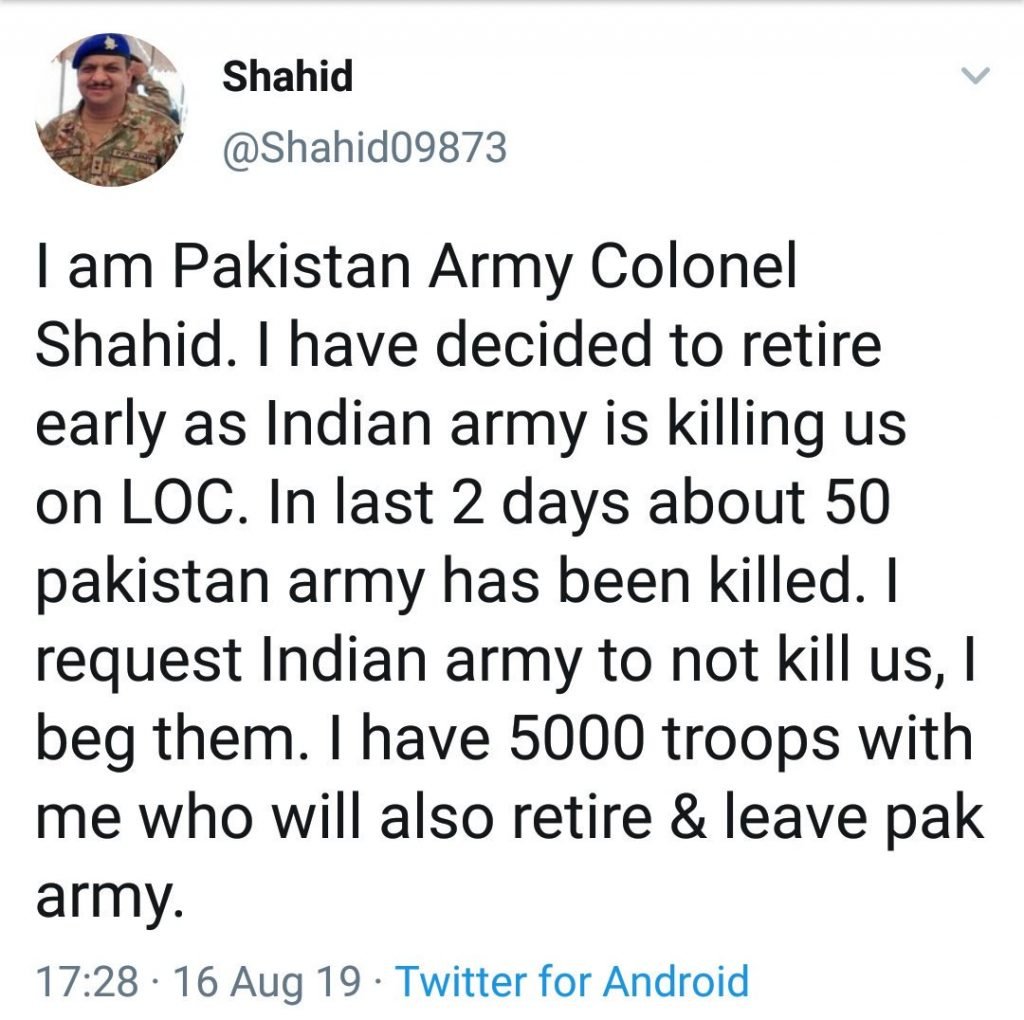
Twitter removed both accounts. This exchange using cloned accounts is a textbook example of Information warfare being waged via social media at a turbulent time in the geopolitics between both nations.
Command Eleven
Another notorious and perhaps even more mysterious player in Islamabad’s PsyOps effort is ‘Command Eleven’. This organisation is not officially a part of the Pakistan Army nor its intelligence apparatus. Command Eleven despite having no official ties with the Pakistani government is said to be one of the ISI’s premier black propaganda outfit. The shadowy organisation is a mysteriously funded think tank headed by retired Lieutenant General Tariq Kahan and Colonel Azam Quadri, along with a team of Cyber analysts and strategic experts.
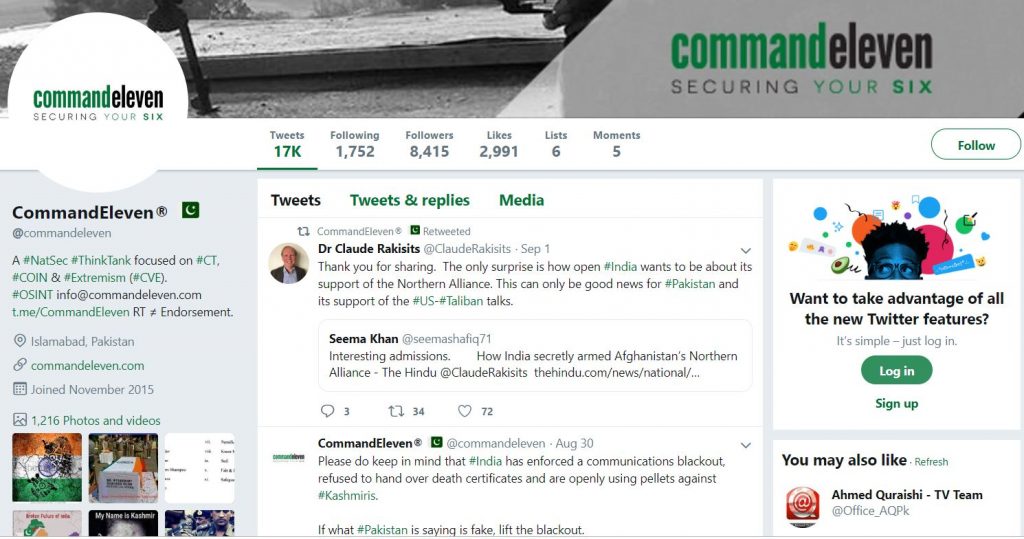
The group is believed to have close ties with the Pakistani military and intelligence establishments. The other core members of the PsyOps unit are Zeeshan Shahid Khan, Syed Ali Jeffery. While they are not former military, Khan and Jaffery have close ties to eminent Pakistani military personnel. The two are also members of another equally obscure think tank known as the Centre for Strategic and Contemporary Research (CSCR).
Case Studies of Pakistans’s Recent Information Operations (IO)
The International Journal of Geopolitics’ The Great Game’ has painstakingly debunked several of Pakistan’s PsyOps attempts breaking down the impact of each attempt via case studies. Sourcing from The Great game is some of the Islamabad’s Information Operations since the Pulwama terror attacks on February 14. Seasoned fake news busters were alarmed by the sheer volume of subversive social media posts spreading like wildfire, unable to keep up, the organised enemy disinformation campaign took its toll with India being a target.
Here are a series of recent Information operations by Pakistan:
Sialkot Attack February 26 2019:
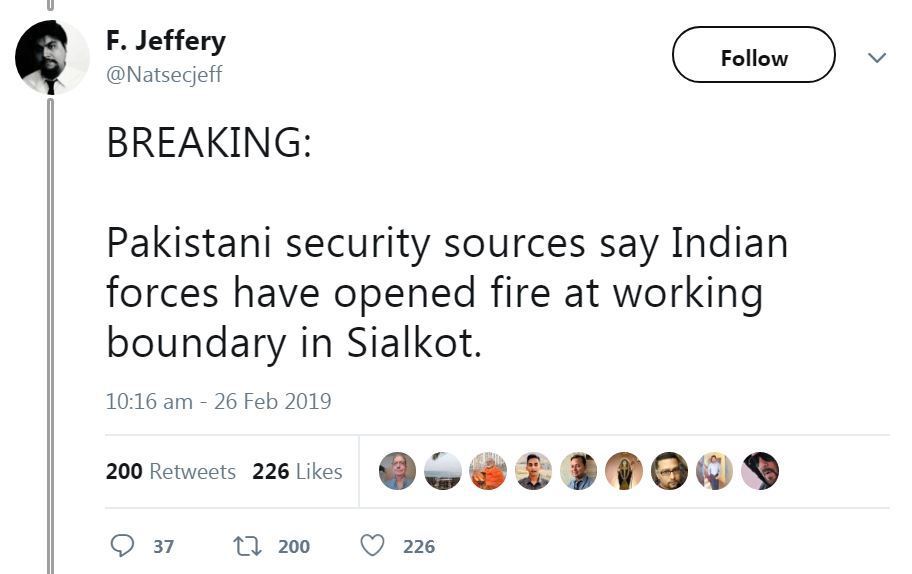
A day before India’s ‘Operation Bandar’ (Balakot Airstrikes) fake news spread of a massive unprovoked artillery attack by the Pakistani Army across the Line of Control (LoC) in Sialkot started to spread. The integrity of the news of Pakistani artillery fire was not thoroughly scrutinised and was published by several leading media publications.
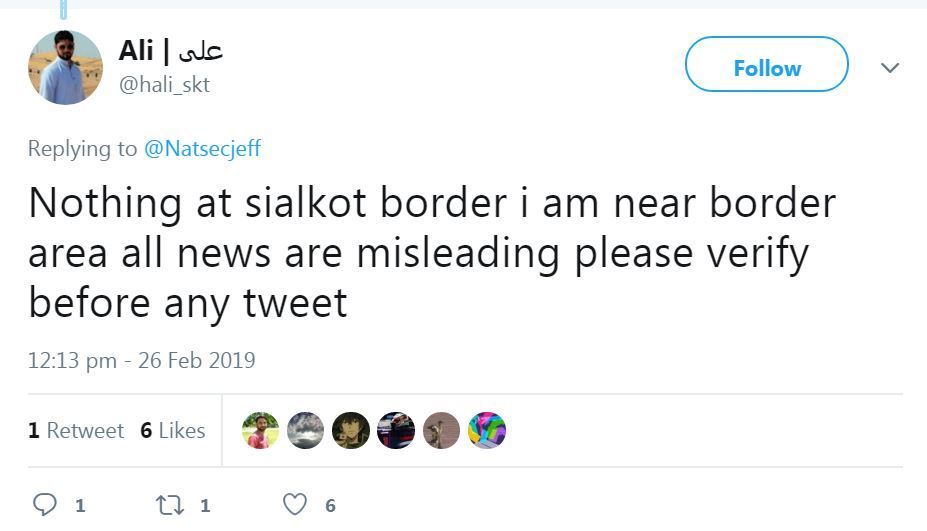
Following a thorough analysis of the footage, it was revealed that the footage of the artillery strike was taken from a four-year-old YouTube video uploaded to ‘Pakistan Military Clips’. The news originated from a twitter account @Natsecjeff (F Jeffery). This twitter user claimed it was confirmed by ‘Pakistan security sources’, however by that time the news had already reached the regional and mainstream media. Many newsreaders still believe the incident to be real.
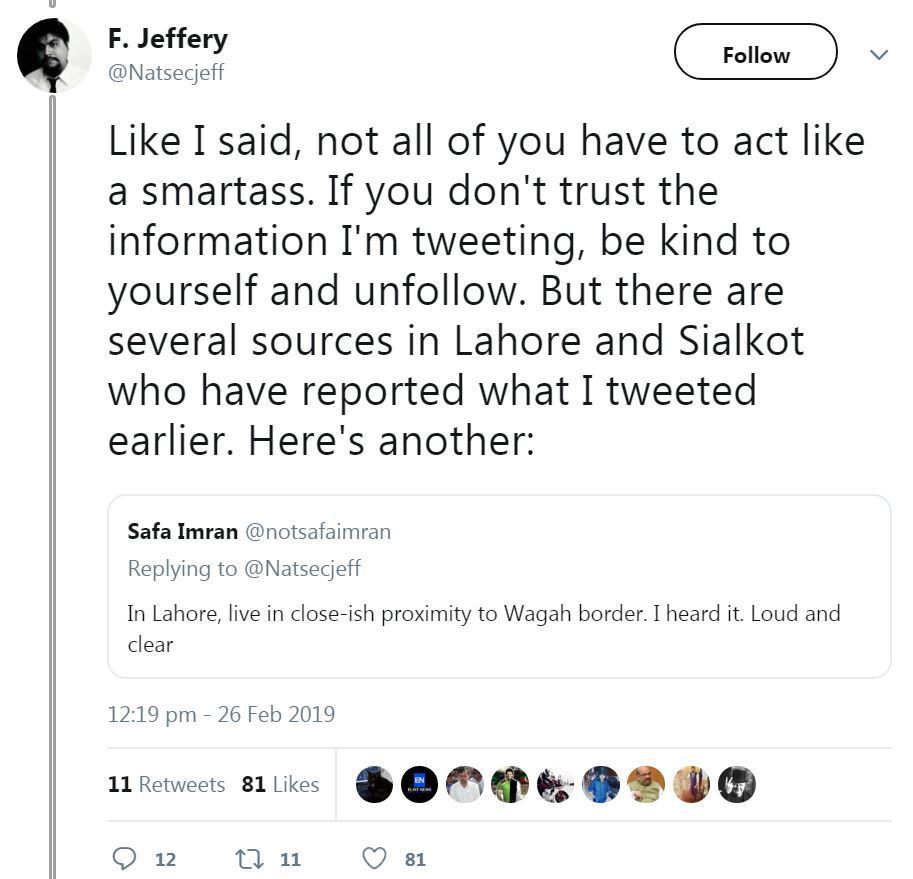
Wing Commander Abhinnadan Captivity Videos and Fake Twitter Handles
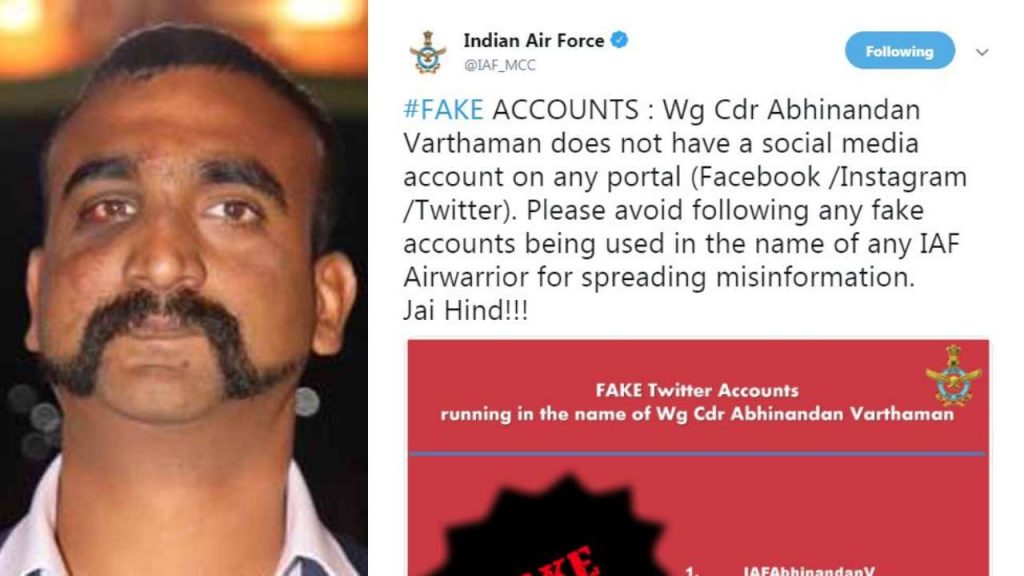
Indian Airforce Pilot, Wing Commander Abhinandan, was captured behind enemy lines following an aerial dog fight with a Pakistani F-16 a day after India’s Balakot airstrikes. Soon videos of the Indian pilots who had spent 60 hours in Pakistani military custody, were circulated by the Pakistan military and civilians, in a direct violation of the Geneva Conventions. Following Wing Cdr. Abhinandan’s release and receiving a heroes welcome, several fake Twitter accounts passing off as the air warrior spawned overnight, spreading damaging misinformation. The IAF observing the possibility of damage was forced to issue an advisory stating that “Wing Cdr. Abhinandan is not on social media”, on their social media pages along with a list of fake Abhinandan accounts.
Fort Abbas Attack March 4 2019:
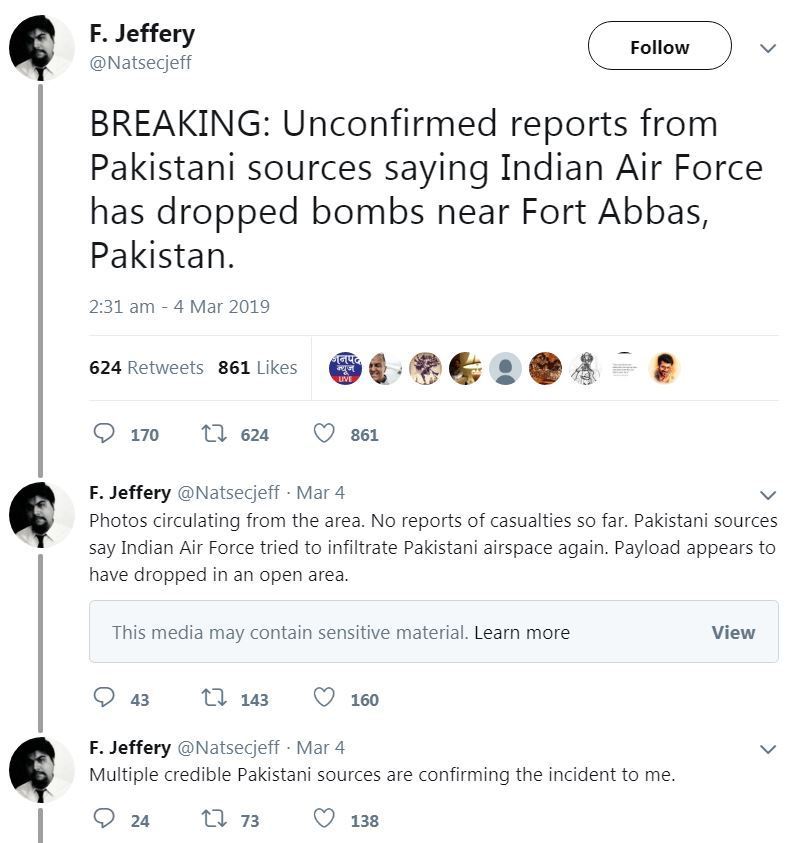
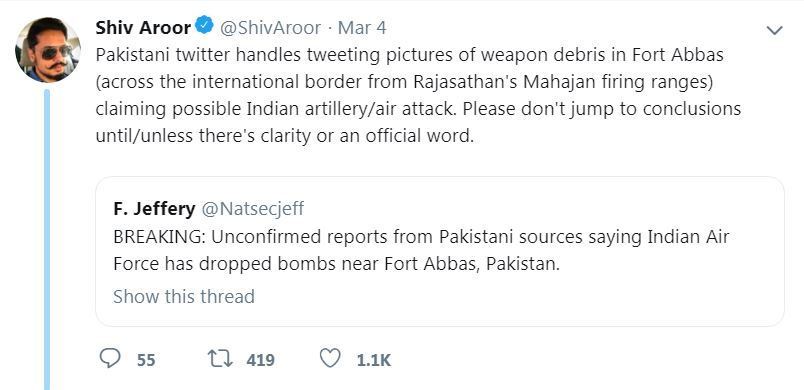
There were unconfirmed reports of an Indian Airforce (IAF) airstrike at Pakistan’s Fort Abbas situated at Pakistan’s Bhawalpur district. Following a similar pattern as the Sialkot attack, the news was said to have been confirmed from ‘Sources within the Pakistani security establishment’ with tweet once again originating from @Natsecjeff. Both the Indian Army and the Indian Airforce denied any such strikes, and gradually Indian journalists started to suspect the malicious news to be arising from Pakistan’s notorious DGISPR.
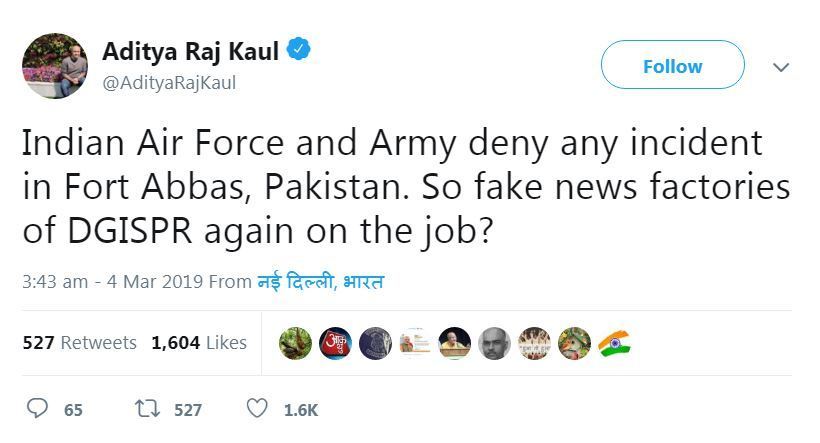
IAF MIG Shot down by an Indian Mi-17 Chopper in a Friendly fire incident March 6:
The news of and Indian Airforce soviet built MiG Aircraft having been shot down by an Indian Mi-17 helicopter in what was reported to be a friendly fire incident went viral. It was later proven to be a Pakistani black propaganda piece planted on a hacked news website. The friendly fire story was first published on a nearly two-year-old website which had claimed it was powered by the Indian Press Association (IPA) in New Delhi.
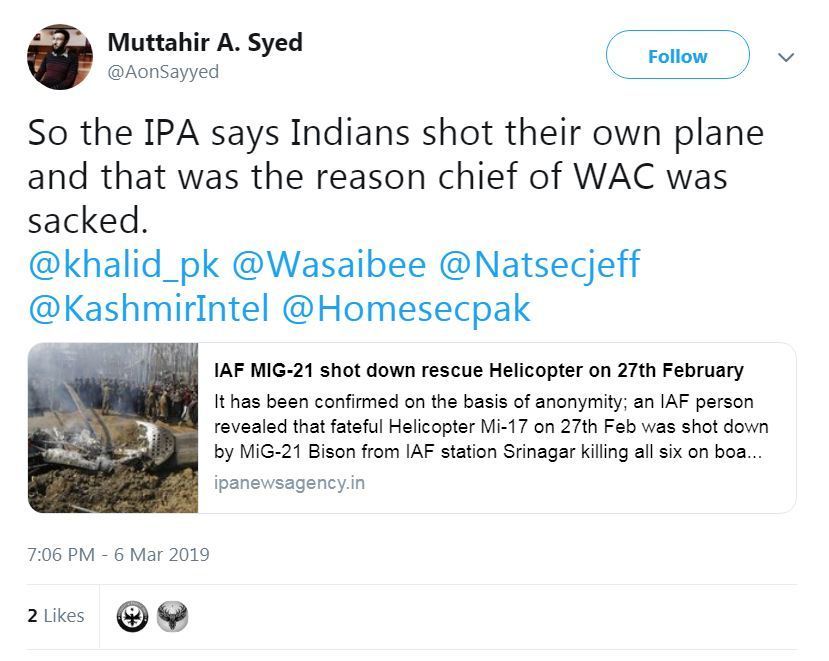
Strangely the story, highlighting an unfortunate friendly fire incident in the Indian Airforce was published in English in an otherwise Hindi language news portal. Upon further investigations by defence news fact-checking website ‘The Great Game,’ it was found that none of the editors of the news organisation was able to be contacted. The fact-checkers informed the Indian defence services of a possible Pakistan planted story after which it was revealed that the story originated and bounced around several Pakistan defence forums.
This was done to spoof a digital trail, from where it was picked up four hours later by Key players in Pakistan’s IO game, once again the Twitter handle @Natsecjeff was found amidst the chaos. Realising it was a planted news story by Pakistan sponsored cyber miscreants, India’s cyber command promptly took down the story from the face of the internet.
Largescale Escalation At LOC
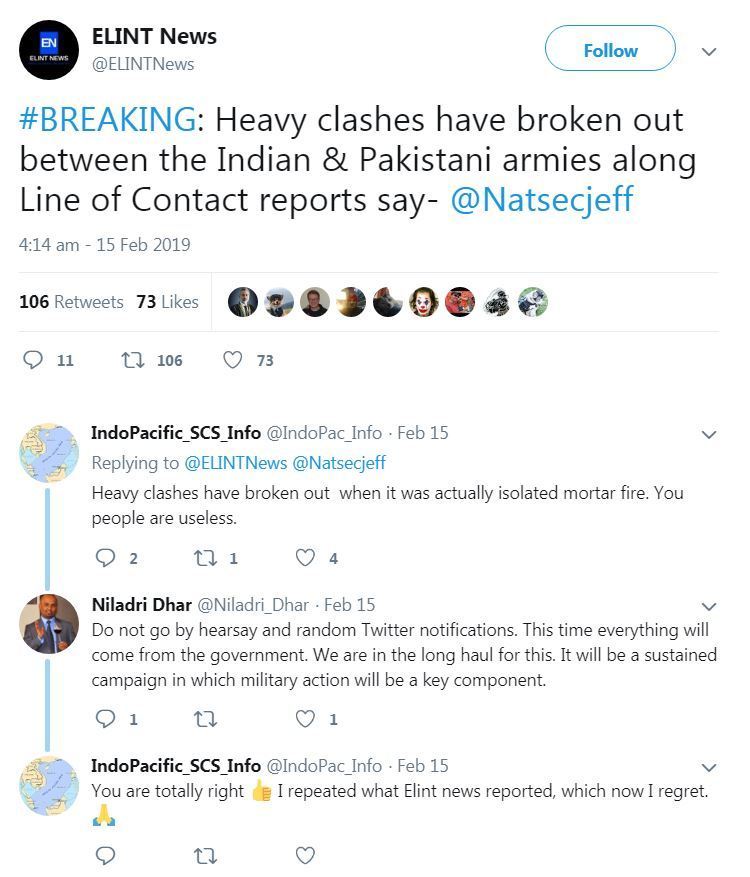
After a few days following the events Operation Bandar which was the codename for The IAF’s Airstrikes at Balakot destroying Pakistan based Jaish-e-Mohammed (JeM) terror camps, which led to escalations between the nuclear-armed countries. A series of images displaying massive troop build-up,

in battle formations were circulating from a Pakistan based blog and twitter handle by the name of @Homesecpak. The story was debunked by a retired Indian army Colonel Vinayak Bhat. The officer exposed that images were from 2014-2016, highlighting well-known artillery positions.
Escalations Between India And China Early March 2019:
Once again, the notorious twitter handle, @Natsecjeff peddled malicious propaganda portraying military aggression between the Indian and Chinese forces. The twitter user tweeted a link of a website quoting an article published on February 9 2018, written on the Doklam Standoff, trying to pass it off as present escalations.
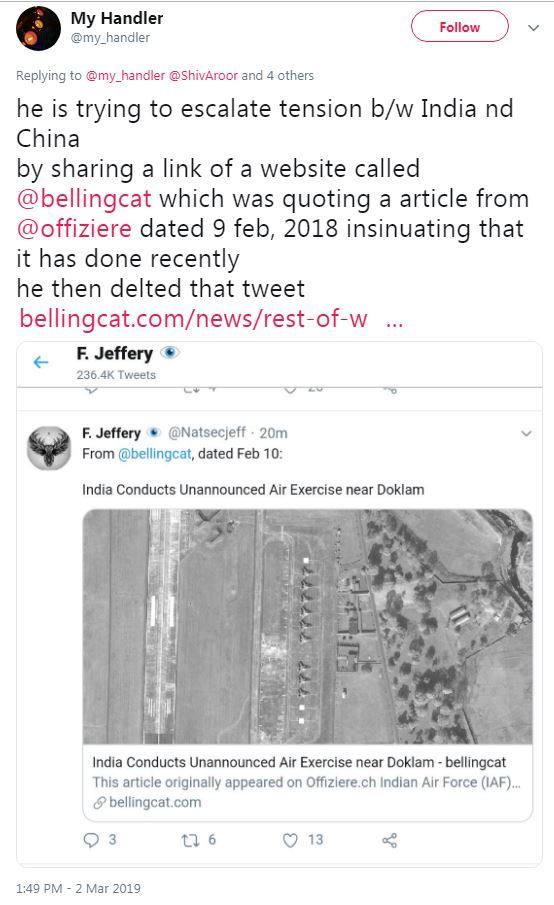
Several other such fake news articles and social media posts have been posted since Pulwama. Many Indian, International journalists and twitter users have disseminated these carefully crafted fake news pieces without verification or at times due to editorial pressures and nefarious intentions to get a scoop.
Who Is @Natsecjeff?
At the centre of recent Pakistan, sponsored information operations have been the notorious twitter handle @Natesecjeff. The dubious Twitter user has been identified as Faran Jeffery, a self-proclaimed neutral observer of India- Pak conflicts.
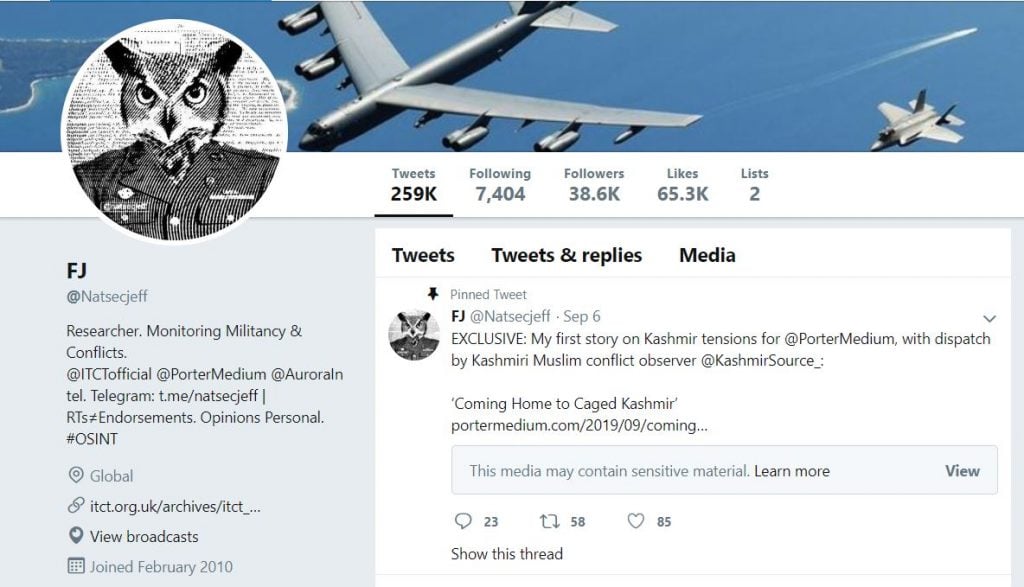
Jeffery is the head of the South Asia desk on terrorism at a London based counter-terrorism think tank International Institute for Counter-Terrorism (ITCT). The security think tank is run by a group of retired Pakistanis, Israeli and British, defence service officers. However, Faran Jeffery along with another @ Kahlid_pk who was also peddling similar planted stories, have been linked to ISI’s PsyOps organisation CommandEleven, where he is the Director-General (DG).
Other Pakistani Non-State ‘Cyber’ Actors:
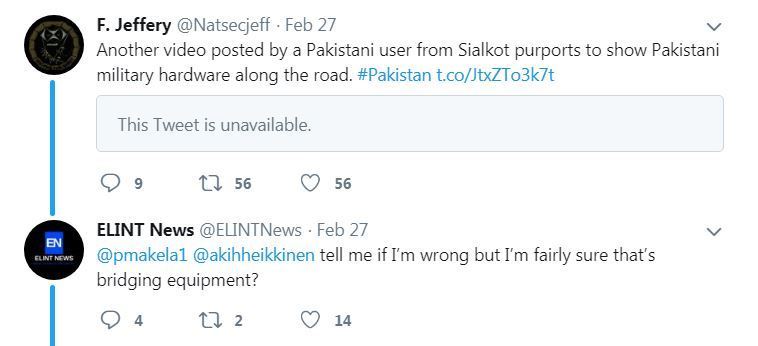
The events following Pulwama and the abrogation of article 370 saw the activation of several Non-state actors on the ISI’s payroll. Many of these planted pieces were unintentionally spread further through American and British twitter handles. This divided the disinformation epidemic into international circles and ended up getting picked up by the international media. A couple of other nefarious handles like @Natsecjeff were, @ELINTNews and @Intel Crab, these were flagged by fact-checking groups and journalists. Several Indian and even Pakistani journalists who exposed command Elevens operations became victims of cyberattacks and other forms of digital harassment.
Pakistan’s Misinformation Blunders:
While Islamabad has seen tactical successes in its ongoing misinformation campaign, the country made a few massive blunders at the international forums.
Pakistani Diplomat Gets Slammed For Showing Fake Picture At The United Nations
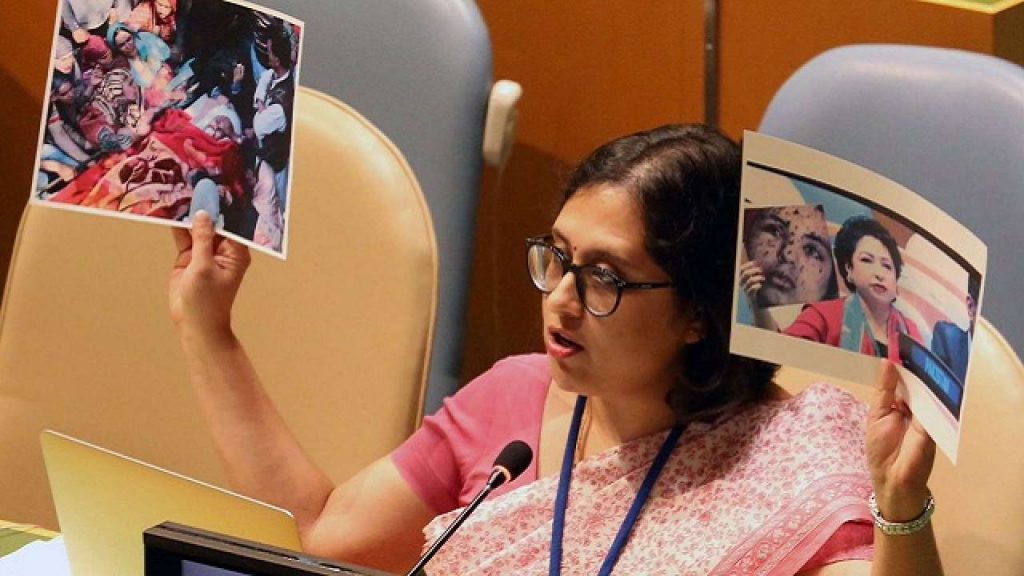
Pakistani Diplomat Malheeha Lodhi in a bid to internationalise the Kashmir issue by highlighting military excess in the valley made a historic blunder at the world stage. The Pakistani representative pulled out a picture of a near lifeless young girl, suffering from severe shrapnel injuries. The gut-wrenching image was meant to advocate the cause of human rights violations by Indian security forces. To her country’s embarrassment, however, it was promptly pointed out to be a picture of a 17-year-old Palestinian girl wounded in the conflict with Israel.
Former Pakistani Envoy Retweeted Picture of Famous Porn Star As Kashmir Victim:
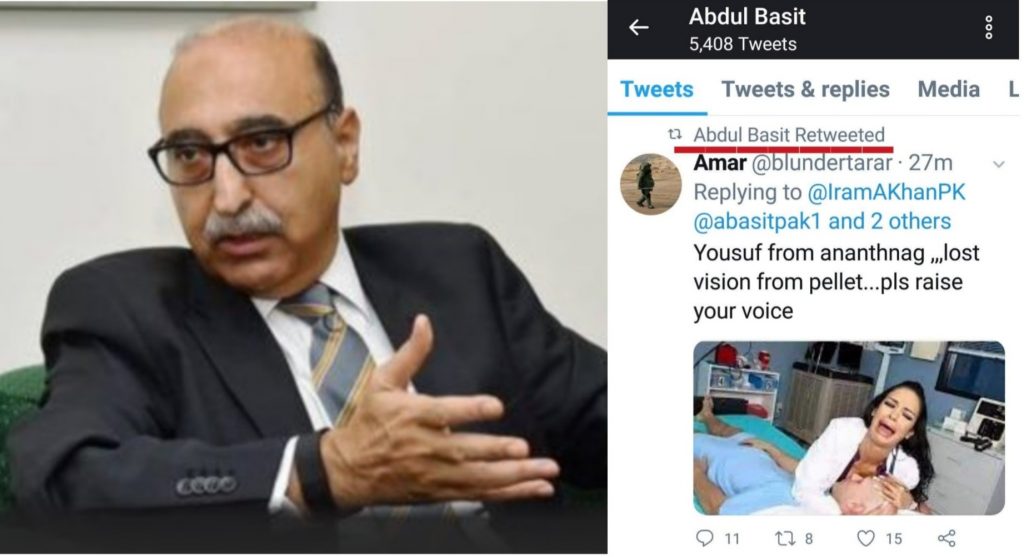
Abdul Basit, a former Pakistani Ambassador, who had previously staunchly denied India’s claims of the 2016 surgical strikes, calling it propaganda, had fallen in a coffin of his design. The Envoy posted a picture of a wailing nurse and a male hospital patient laying down motionless, tweeting that it was a man wounded by Indian Security forces in Kashmir amidst the communication blockade in place after the repeal of article 370. Twitter users around the world quickly trolled the Pakistani diplomat for tweeting a picture of famous porn star Johnny Sims!
Cyber Jihad: Online Radicalisation Of Youth By Pakistan’s Proxies:
Extremist outfits around the worlds have extensively utilised social media to radicalise potential recruits. The Islamic State of Iraq and Syria (ISIS) which grew widespread notoriety since 2014 has perfected online radicalisation into an art form. The group has successfully managed to radicalise Indian youth from the mainland. ISIS has tried to make forays into Kashmir and is working on its terror recruitment base. Similarly, Pakistan sponsored terror groups in the valley has weaponised social media, poisoning the young Kashmiri psyche with venomous propaganda.
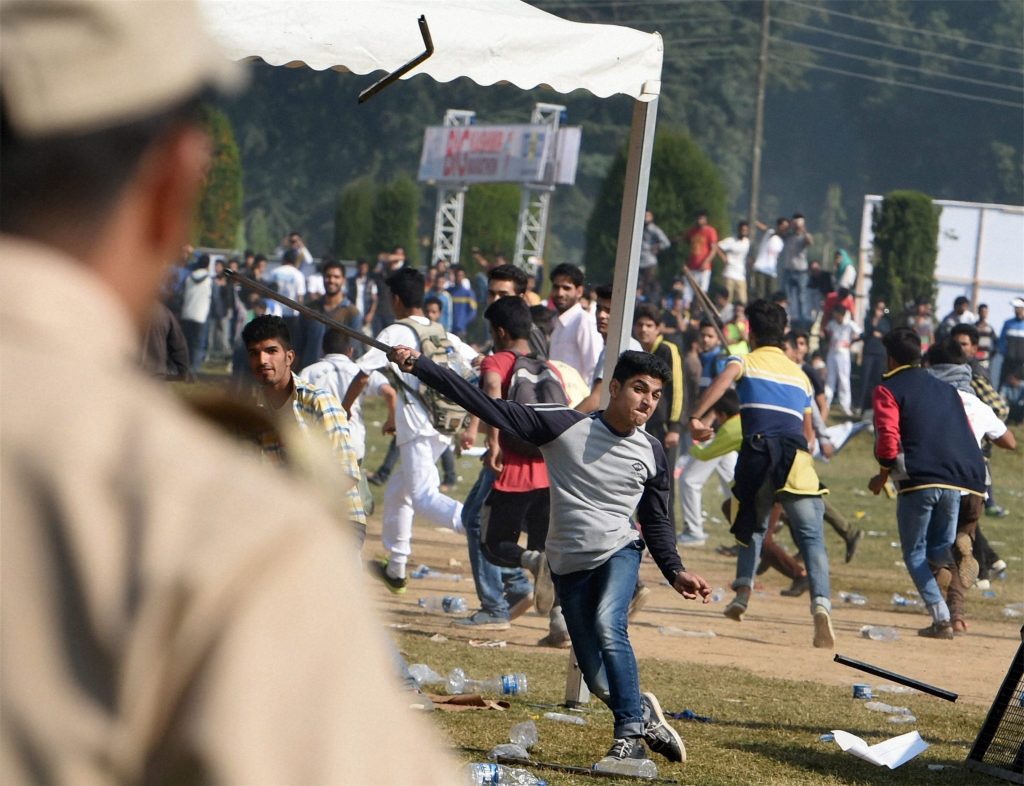
These sophisticated PsyOps campaigns have been successful in provoking the youth into waging ‘Jihad’ picking up arms against the state. Today Pakistan has successfully managed to take advantage of the volatile situation in Kashmir with a bulk of Islamabad’s trained militants coming from Indian Administered Kashmir (IAK) itself.
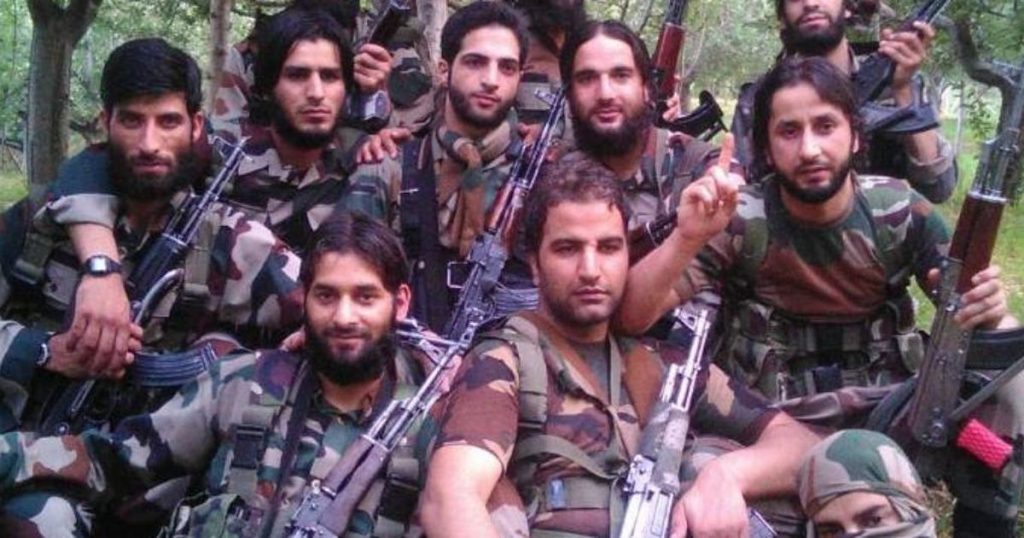
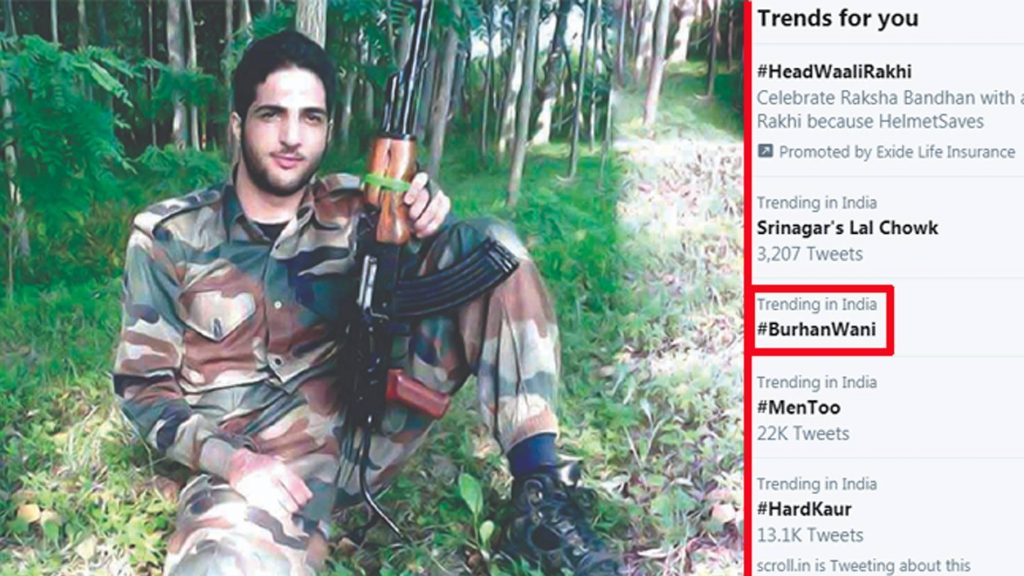
Social media recruitment may perhaps widely be credited to the young Hizbul Mujahideen commander Burhan Wani, who was neutralised by security forces in 2016. The young terrorist leader was known for his employments of popular social media platforms such as Facebook, Youtube, Whatsapp, Skype, telegram among a host of other platforms. His recruitment success and following prompted different terror outfits such as the Lashkar-e-Taiba (LeT) and Jaish-e-Mohammed to employ similar tactics. The killing of the young terror commander spiked militancy in the valley, with thousands of young Kashmiri men following the path of jihad, to avenge the death of their leader. Burhan Wani’s death gave jihadist groups a recruitment overdrive!
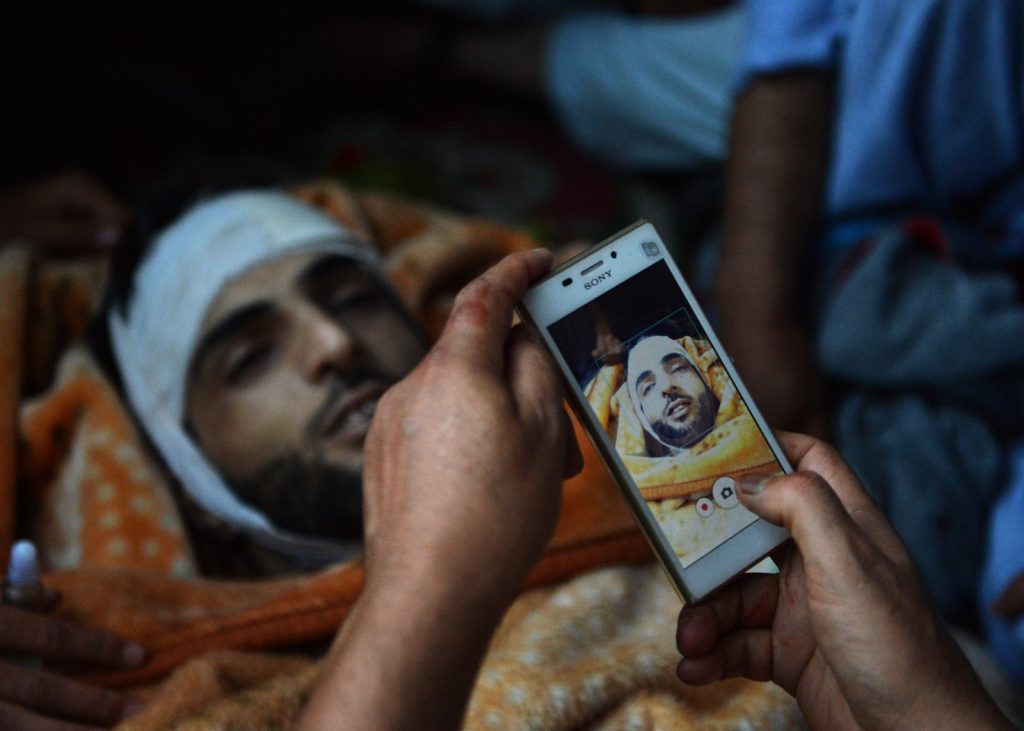
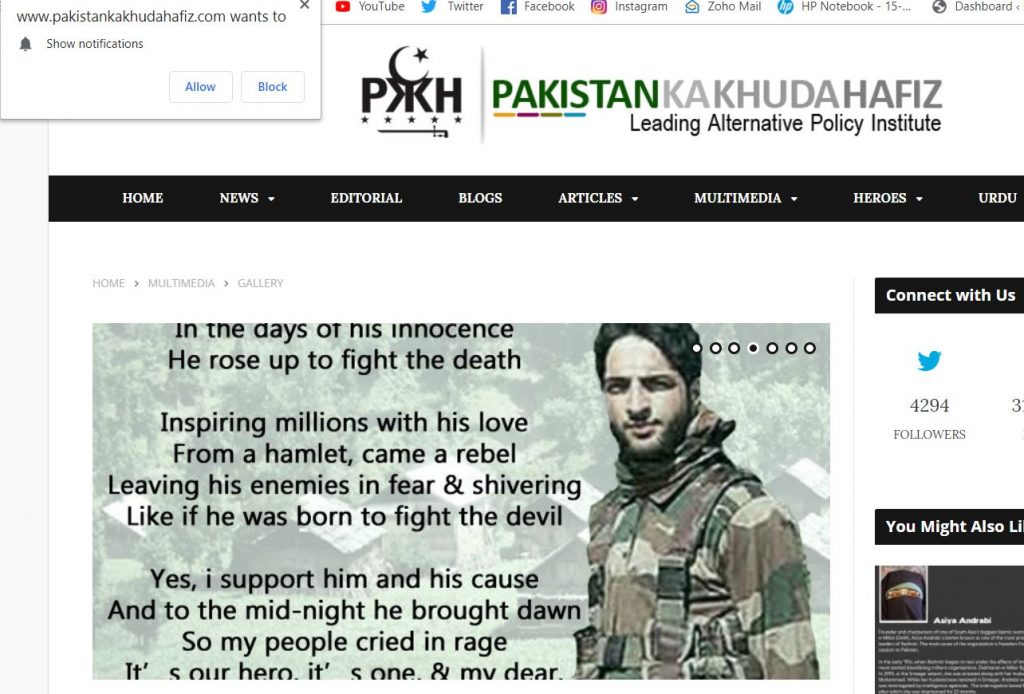
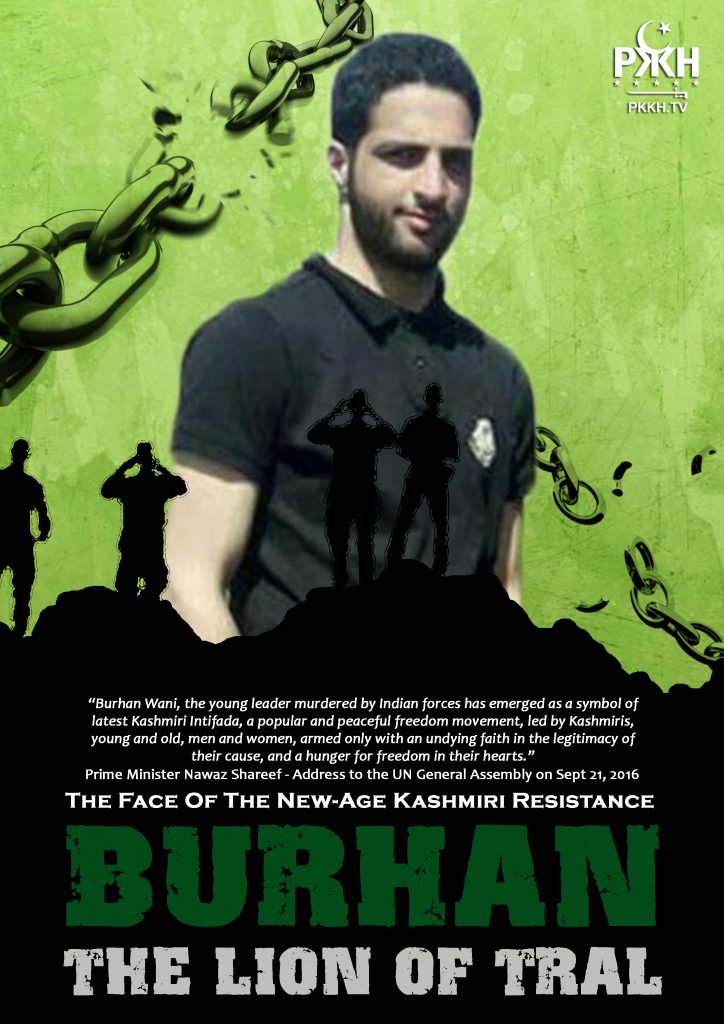
Burhan Wani’s death led to an unfortunate legacy of homegrown insurgent action in the valley. According to an NIA probe in 2017 following Wani’s encounter by the forces. It was revealed that over 79 Whatsapp groups, with 6,386 phone numbers were used to mobilise mobs in coordinated stone-pelting campaigns.
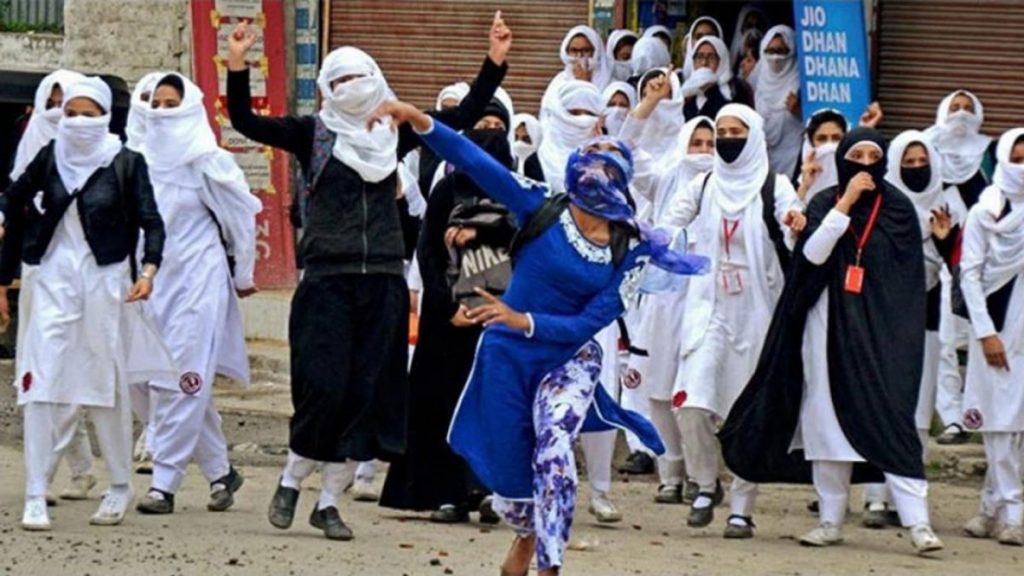
These youth were paid based on the forces they hurled stones. An estimated 1,000 numbers were operated from Pakistan, with some from Gulf countries. It was also revealed that the groups operating from the valley had administrators and handlers in Pakistan, with direct links to Pakistans premier spy agency, the ISI. Furthermore over 300 Whatsapp groups were active, with the sole objective of disrupting Counter Insurgency Operations (COIN-OPS) by the security forces (Mainly the Rashtriya Rifles).
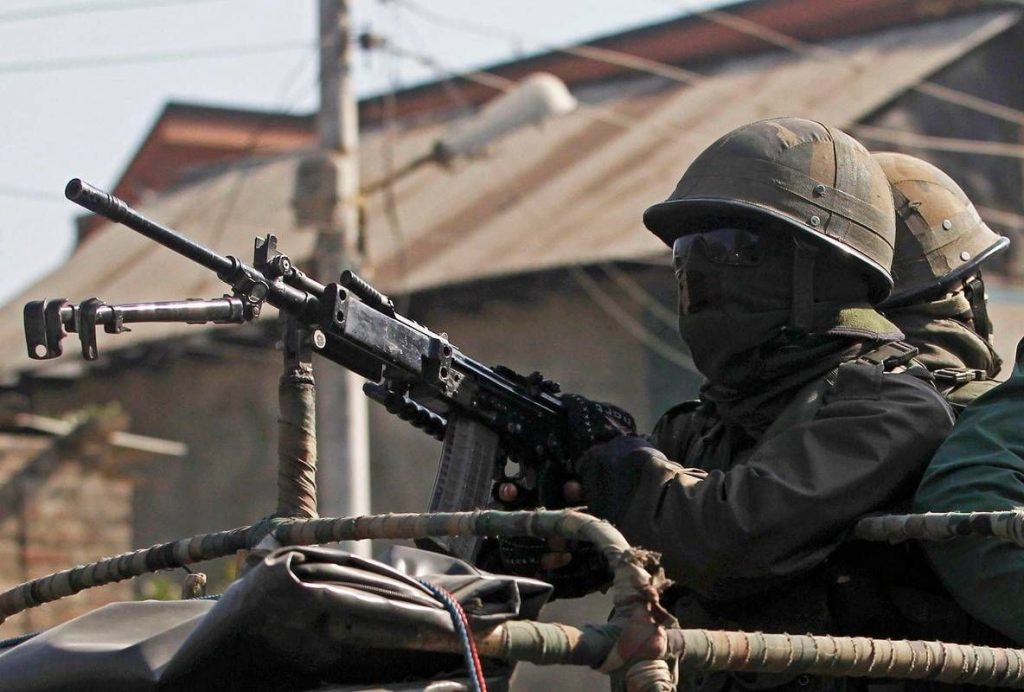
Specialised cells were organised, consisting of dedicated youth and women formed to aid and abet the escape of dreaded terrorists cornered in an encounter. The employment of civilians non-combatants forced the forces into submission, fighting with their hands tied behind their backs. A large part of Pakistan’s PsyOps campaigns in the valley involves hateful imagery.
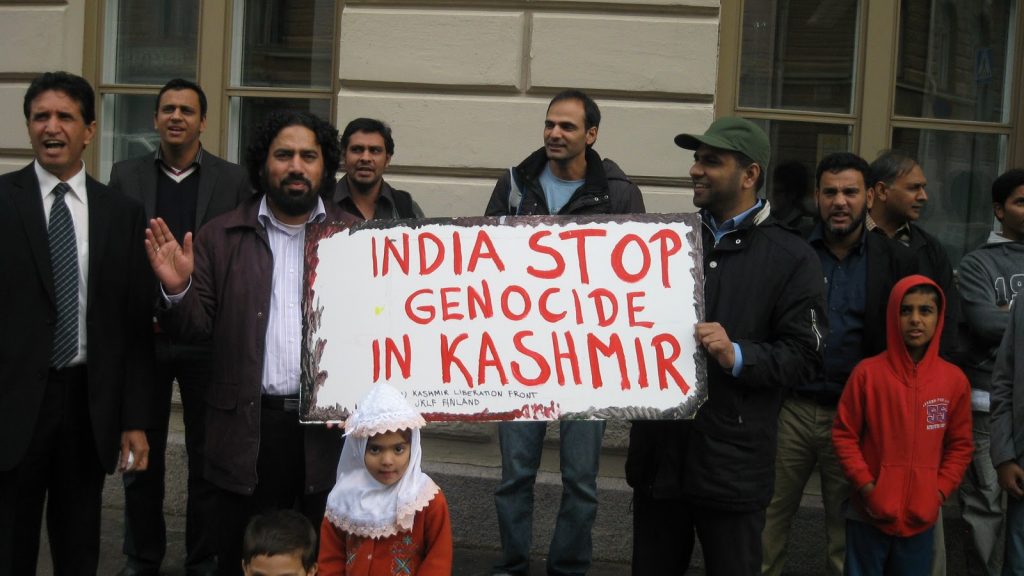
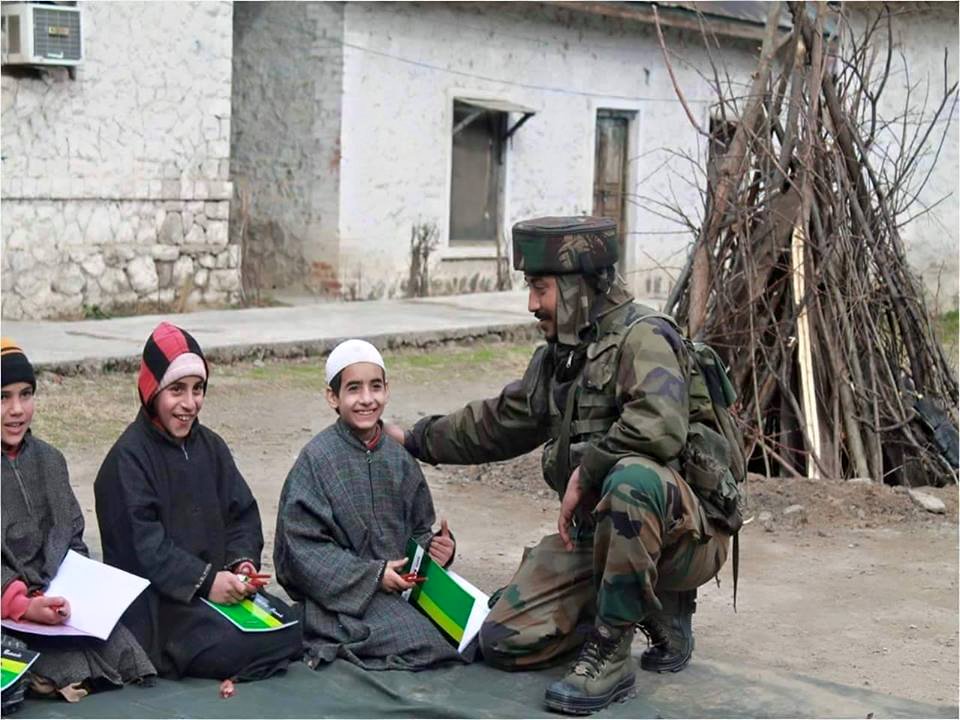
The ISI aided by local Madrasas (Religious schools) indoctrinates impressionable Kashmiri youth by teaching them about atrocities and persecution faced by Muslims in the mainland. The students of these religious schools are shown graphic images of riots, such as the ones at Godhra. They are shown communally charged images and videos of the Babri Masjid demolition, and videos of young terror recruits who have gone on to do their sacred duty. The radicalisation targets several vulnerabilities and imbibes a sense of purpose amongst the youth.
India’s Counter-Propaganda Unit: Information Warfare Wing And ADGPI
The Defence Ministry to counter Pakistans far-reaching misinformation machinery and planted stories which have repeatedly found its way into the mainstream the media has announced the creation of the Information Warfare Wing earlier this year. The Information warfare wing has been designed to combat any form of Pakistani mischief undertaken by the country or its non-state actors. The counter-propaganda outfit will also serve to neutralise the ISI’s increasing online radicalisation programs in the Kashmir valley.
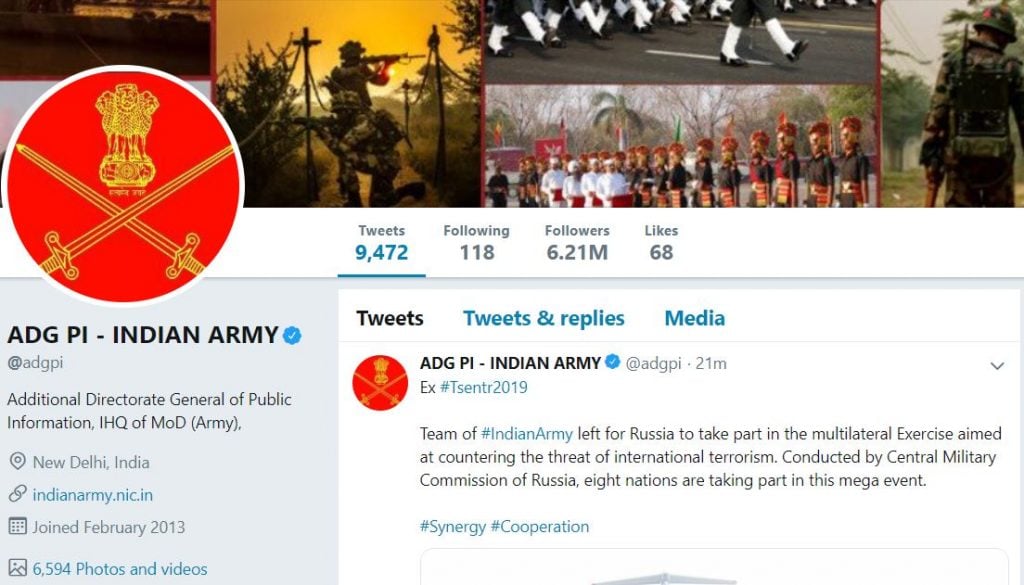
The IW branch will be headed by a Lt Gen. Rank officer, under a newly created appointment by the name of Deputy Chief of Staff (Strategy). The new Information Warfare wing will remain Independent of the Indian Army’s Additional Directorate General of Public Information (ADGPI), which is the army’s social media and perception management cell. The ADGPI is India’s equivalent to Pakistan’s notorious DGISPR. The formation of this new hybrid warfare unit will give the Indian defence services the ability to counter Pakistan’s false narratives.
A Troubling Picture

The success of Pakistan’s multi-layered PsyOps campaign combined with the challenges of monitoring the internet, owing to the ‘Security vs Privacy debate’ paints a terrifying picture of the way today’s wars are fought. The unprecedented reach of such subliminal messaging blurs the line between civilian, victim and enemy combatant.

